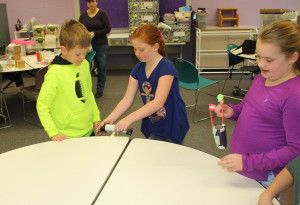
BY JESSICA STEELEY
Clarkston News Staff Writer
A tinkering room is coming to Pine Knob Elementary for student exploration and imagination.
Principal Jodi Yeloushan said teachers do a lot of tinkering in their own classrooms so she wants to provide a space for teachers to bring their classes and allow students to work on projects and hands-on activities.
“It allows students to think outside the box, to work cooperatively with one another, to be able to see that they can have different types of thinking and still solve a problem,” Yeloushan said.
She described Janice Driver, a Pine Knob second grade teacher, as having a passion for tinkering. Driver collects broken electronics and has her students open them up and examine how they would work.
“A lot of kids have so much electronics right now they really don’t understand the workings of them. It allows them to see inside that kind of thing and put them in a situation where they’re creating or exploring how things are created,” she said.
The construction of the tinkering room goes along with the Cultures of Thinking being used at schools throughout the Clarkston Community Schools district.
Yeloushan said tinkering is often followed by thinking routines where students can visibly show their reaction to the activity.
Not many classes currently use the room, as Yeloushan said it’s only about 50 percent complete based on what they want to do.
The room is already funded by grants from Clarkston Foundation and Clarkston Optimists. Right now they’re working on building everything into the room.
Fourth grade teacher Karen Kumon, another teacher helping to construct the tinkering room along with Driver, said there are plans for several different components in the room including a magnetic wall, a sewing area, water exploration, a tile wall for painting and a green screen.
“Our vision here is we create a room and an environment people can start projects, leave projects, put projects on display once they’ve been created,” Kumon said.
“You have a much different way your brain processes and a very different method when you are hands-on with something than when you’re just being told that this is a fact.”
But tinkering is more than just purposeful play. Kumon said it allows kids to take learning into their own hands and apply the scientific method and math equations in real-life situations. It ties in academic subjects with life skills, such as problem solving, teamwork and perseverance.
Driver views tinkering as a way for students to build and explore, all the while being able to fail and try again, there’s more time for them to discover and figure out what does and doesn’t work.
“In second grade we do a lot with measurement, so I gave the kids a challenge to create some type of catapult and solve the problem, does the weight or the mass of an object affect how far it will fly,” Driver said.
“They had to build a catapult and they had to catapult four or five different things made of different materials and measure each one and then come up with a claim as to what they found out,” she explained.
Kumon said such activities allow students to take a deeper look into what they’re learning rather than just believing information is true because the teacher says so.
Children make connections at a higher level and retain information better when learning through hands-on instruction.
“It’s unstructured learning within a structured environment,” Yeloushan said. “You definitely see kids come alive in those type of learning environments – where they can explore and they can break things apart without getting in trouble, and working with their hands, working with their friends.”
